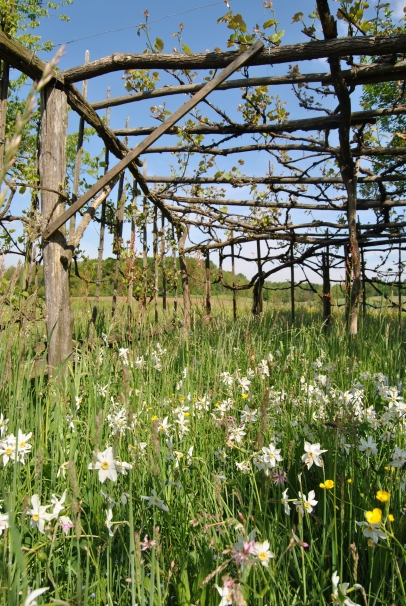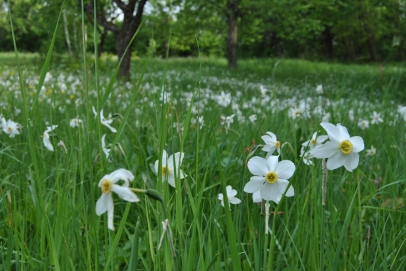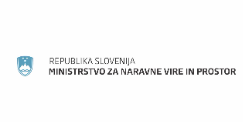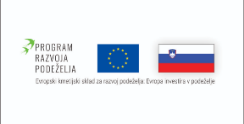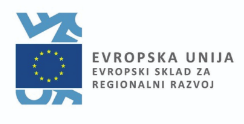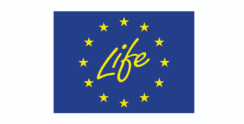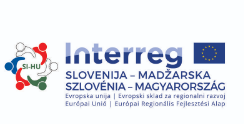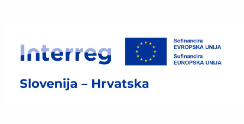Poets daffodil
Within the area of the Goričko Nature Park the poets daffodil (Narcissus poeticus ssp. radiiflorus) can be found only in municipalities of Cankova and Rogašovci. Up to 40 cm tall herbaceous perennial grows from the bulb. It grows on unfertilized soil in late-mowed meadows or orchards. In some parts of the area they have been preserved in gardens and fences, due to the proper approach (late mowing of the grass) in quite large numbers. It has four from 20 to 40 cm long and up to 2.5 cm wide leaves, while its stem is erect, hexagonal, slightly compressed and hollow. Individual blossoms are starry and white. Six petals are tubularly fused. The red-orange pendant is flat in shape and contains 6 anthers and a three-part receptive stigma. White blossoms can be admired from the second half of April to mid-May, with a peak of blooming around May 1st. The fruit is a fleshy head, which we avoid mowing until it ripens (becomes yellow in colour).
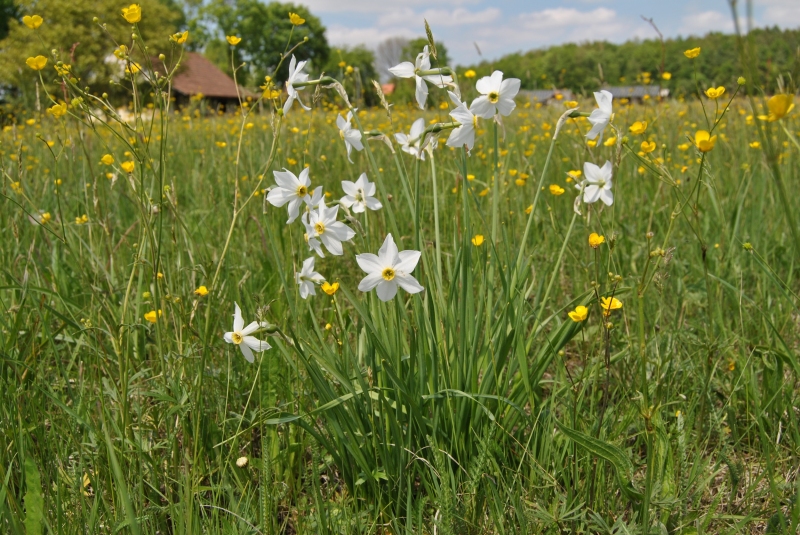
Poet daffodil often grows in clump ![]() M. Podletnik
M. Podletnik
Poets daffodil is a poisonous plant, particularly poisonous is the bulb. Several types of alkaloids can be found within the specimens: homolycorine, narcissidine, lycorine, haemanthamine, tazettine, lycorenine, anhydromethylethylpseudolycorine, methylpseudolycorine, phiancine, magnarcine and narcissamine. The signs of poisoning are nausea, vomiting, diarrhea, shock, damage to the stomach and damage to the intestines. Florists may also develop so-called narcissistic dermatitis. Scented substances (essential oils) from the plant were used in the past for parfume-making.
Daffodils Latin name comes from the ancient Greek myth of Nárkissos. He was a son of the river god Cephissus and nymph Liriope. Goddess Nemesis lured him to the lake, on whose surface young man saw reflection of his image and fell in love with it. Unable to look away he died by the lake. The gods turned him into a flower by his name, which has his pale complexion and yellow heart in a fiery red circle. Karl Linne named this plan Narcissus poeticus. The name Nárkissos comes from greek work narkm (narke), which means to sleep, to go numb. Nárkissos was also a hunter from the area of Thespie and Beotia. He was known for his beauty.
Daffodil has many native and locally distinctive names in Slovenia. Name potkolonec is given to it in Cankova, piklonec and piklanec in Gerlinci and Pertoča. In Veržej they call it fünkešnica. Elsewhere in Slovenia it got names such as beli narcis (white daffodil), gorski narcis (mountain daffodil), bedenica, ključavnica (keyhole), binkoštnica (Pentecost flower), čarovnica (witch), medenica (honey flower) and jurjevica (St. Georges flower). In Germany they gave it names Dichter-Narzisse, Montreux-Narzisse and Echte Narzisse. The Hungarians call it henye boroszlán. Its other English names are poets narcissus, nargis, pheasants eye, findern flower, and pinkster lily. French call it narcisse des poetes, while Croatians know it as sunovrat (suns neck). The municipality of Cankova chose the daffodil as an symbol in the municipalitys coat of arms. Their coat of arms is depicted on the shield coloured blue and silver, with white daffodil with eight petals as a symbol of eight settlements within the municipality. Across the two fields three-wavy double wave symbolizes rivers Kučnica and Ledava.
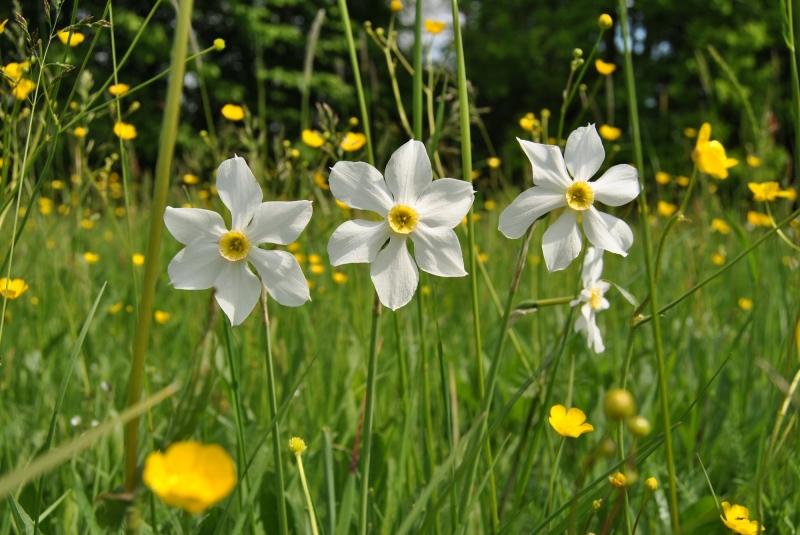
Close up flowers ![]() M. Podletnik
M. Podletnik
The genus of daffodil is widespread through Europe, Africa and Asia. In Slovenia poets daffodil can be found on Golica, Snežnik, Kras, Zasavje, Kočevsko and in Pomurje. About 50 growth places are known in Goričko, mostly in the western side in the municipalities of Cankova and Rogašovci. These are scattered habitats, mostly on wet meadows, meadow orchards, old vineyards and alder logs. Growth locations of daffodils in the Goričko Nature Park are regularly recorded. A daffodil is a protected species of a plant, thus it is forbidden to intentionally destroy, damage or pluck it.

